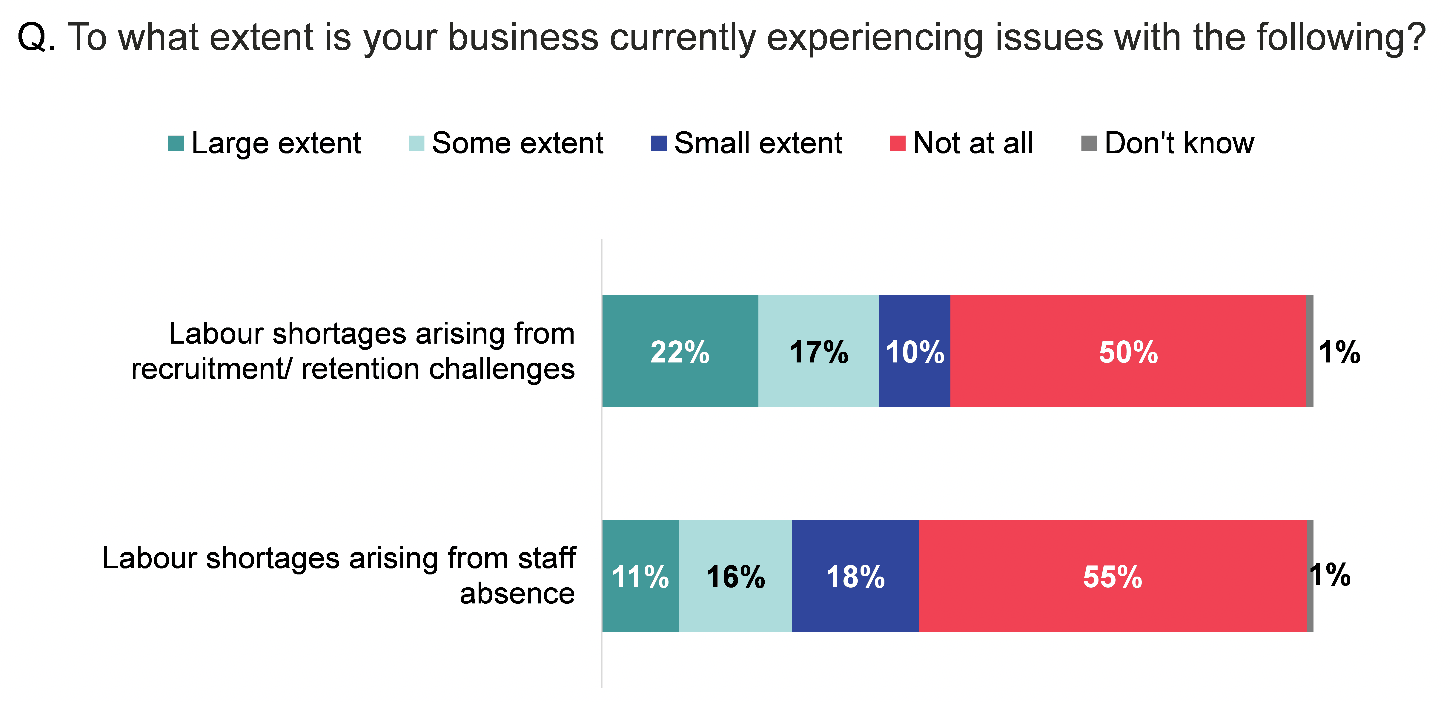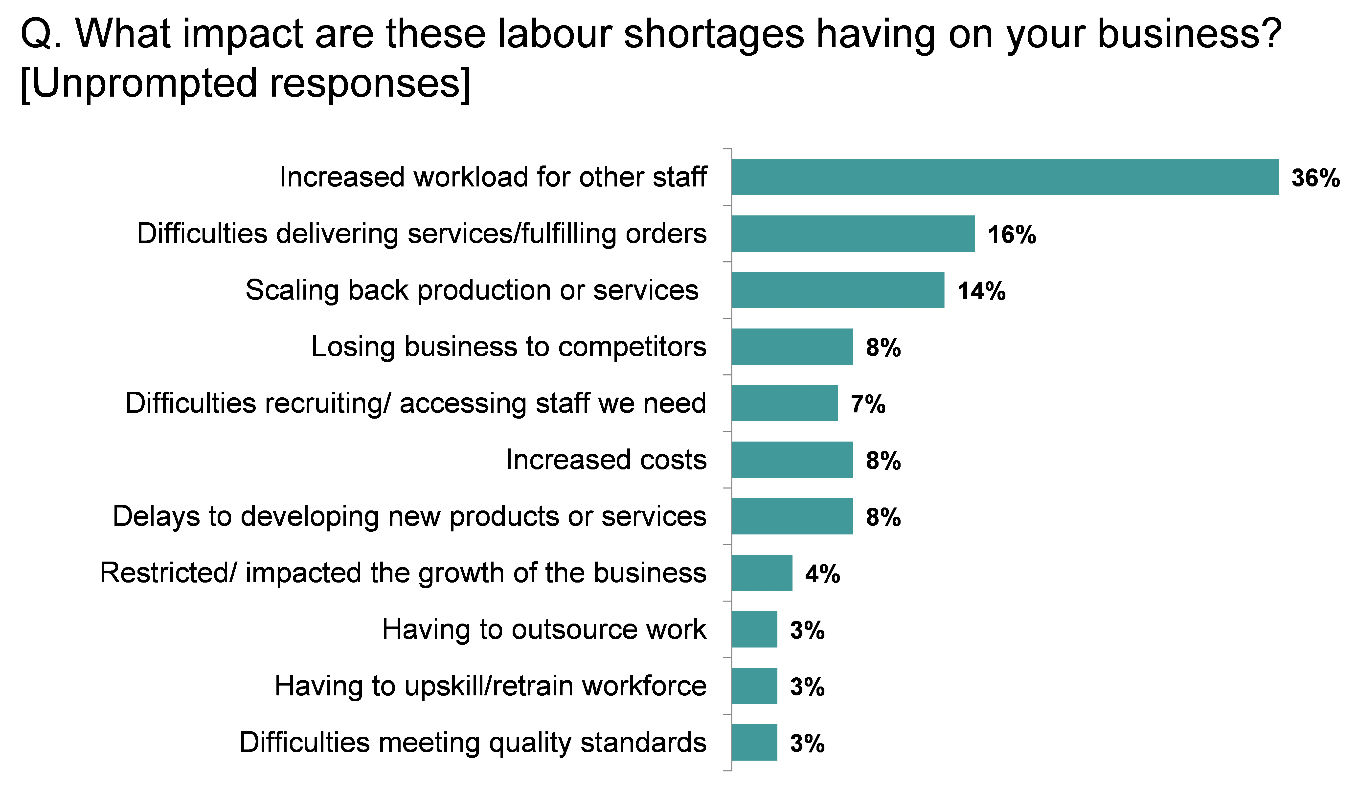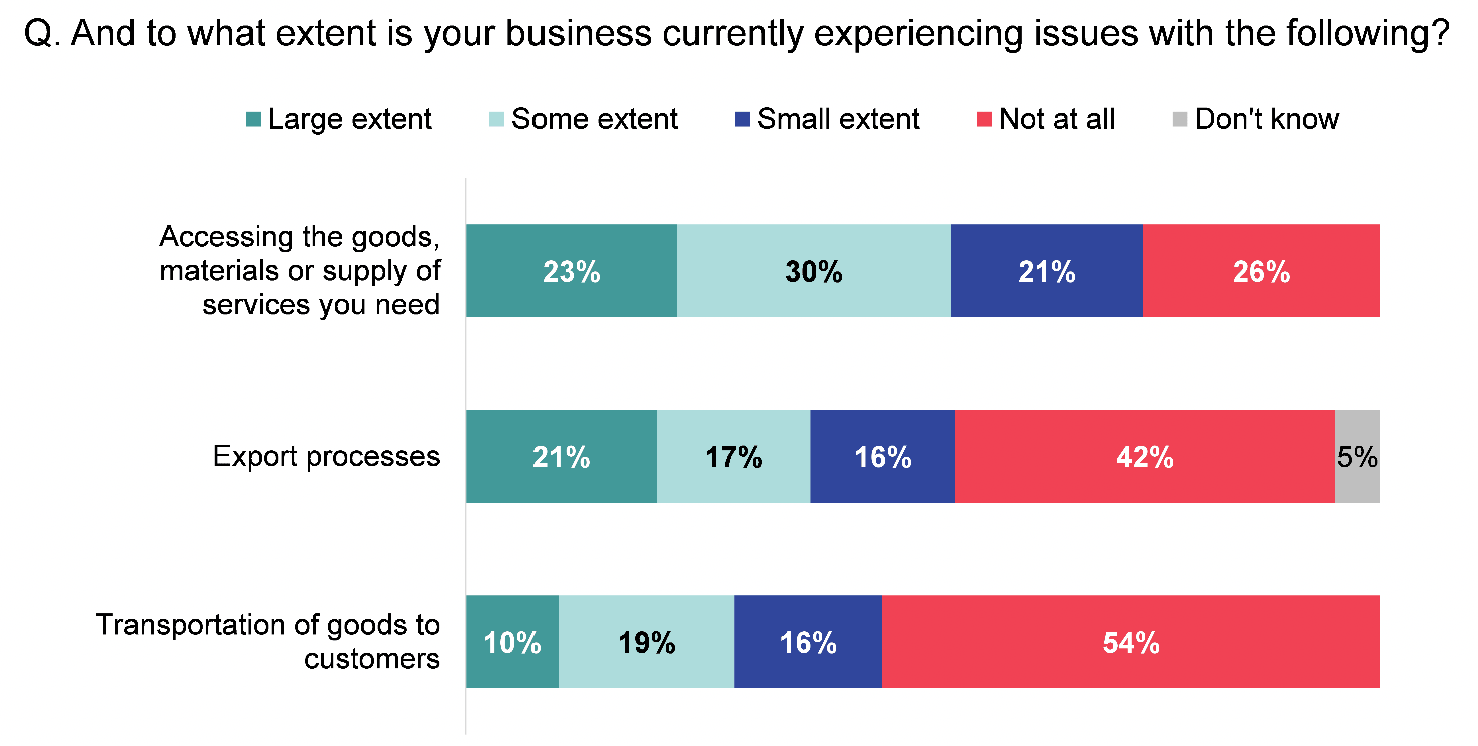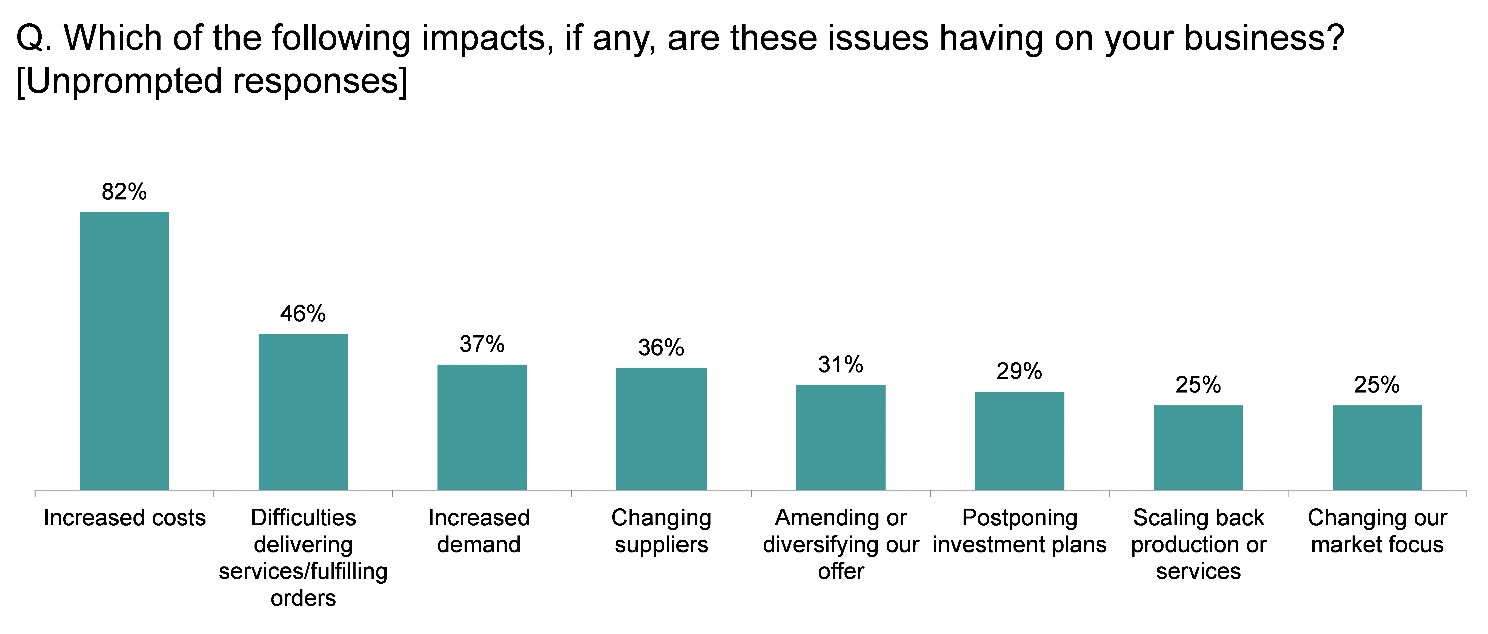Rural Scotland Business Panel survey: report
This report presents findings from the first Rural Scotland Business Panel survey carried out in October/November 2021.
6. Labour and supply chain issues
Key findings
Among businesses for whom it was relevant, 48% said they had experienced labour shortages: 39% arising from recruitment or retention challenges, and 38% arising from staff absence.
Businesses reported a range of impacts from labour shortages. The three most common were: increased workload for other staff (36%) difficulties in delivering services or fulfilling orders (16%) and scaling back production or services (14%).
Among those for whom it was relevant, just under three quarters (73%) were experiencing some form of supply chain issue. In particular, 70% were experiencing issues accessing the goods, materials, or supply of services they needed, while around half were experiencing issues with export processes (47%) and transportation of goods to customers (44%).
Four in five (82%) businesses that were experiencing supply chain issues said this had led to increased costs.
Experiences of labour shortages
Among those for whom it was relevant, 48% said they had experienced labour shortages. Of those, 39% said it arose from recruitment or retention challenges, and 38% said it arose from staff absence (Figure 6.1).

Base: All for whom it applied
Variation in experience of labour shortages
Labour shortages were more common than average among businesses in the Highlands and Islands overall (57% experienced shortages, compared with 49% in the South of Scotland and 44% in the rest of rural Scotland). The Highlands and Islands were also more likely to have experienced each type of shortage: those arising from recruitment or retention challenges (49% compared with 40% and 35% respectively), and those arising from staff absences (44% compared with 37% and 36%).
Businesses on islands were more likely than average to have experienced both shortages as a result of recruitment and retention challenges (52%) and staff absence (46%).
Larger employers (with 25+ staff) and tourism businesses were also more likely to experience labour shortages (85% and 59% respectively had experienced some form of shortage).
Those aiming to grow (46%) and importing from Northern Ireland (45%) were more likely than average (39%) to experience labour shortages specifically as a result of recruitment or retention challenges.
Impacts of labour shortages
Businesses reported a range of impacts from labour shortages (Figure 6.2). The three most common were: increased workload for other staff (36%) difficulties in delivering services or fulfilling orders (16%) and scaling back production or services (14%).

Base: All experiencing Labour shortages (1,012)
Variation in impacts of labour shortages
Impacts of labour shortages varied somewhat by region. Businesses in the Highlands and Islands were more likely than average to say their labour shortages resulted in: difficulties delivering services or fulfilling orders (21%) and delays to developing new products or services (11%).
Those in the South of Scotland, on the hand, were more likely to say labour shortages had caused increased workload for other staff (48%).
In terms of further variation:
- Tourism businesses were more likely to report scaling back production or services (25%).
- Those in remote rural locations were more likely to say it caused difficulties recruiting or accessing the staff they needed (13%)
- Larger businesses (25+) were more likely to say they had to upskill or retrain their workforce (7%), or had difficulties introducing new practices (7%) and meeting quality standards (6%).
Experiences of supply chain issues
Among businesses for whom it was relevant, just under three quarters (73%) were experiencing some form of supply chain issue. In particular, 70% were experiencing issues accessing the goods, materials, or supply of services they needed, while just under half were experiencing issues with export processes (47%) and transportation of goods to customers (44%) (Figure 6.3).

Base: All for whom it applied
Variation in supply chain issues
Supply chain issues were more of an issue for businesses in the Highlands and Islands and South of Scotland than the rest of rural Scotland, specifically in relation to accessing the goods, materials or services they needed (74% and 71% compared with 68%) and export processes (53% and 50% compared with 44%) (Table 6.1).
| Supply chain issue | Highlands and Islands (%) | South of Scotland (%) | Rest of Rural Scotland (%) | Total (%) |
|---|---|---|---|---|
| Accessing the goods, materials or supply of services you need | 74* | 71* | 68 | 70 |
| Export processes | 53* | 50* | 44 | 47 |
| Transportation of goods to customers | 45 | 40 | 45 | 44 |
| Base (all for whom it applied) | ||||
(figures marked with * are higher than those for rest of rural Scotland)
Businesses in remote rural and island areas were both more likely than average to have experienced issues accessing the goods, materials or services they needed (73% and 75% respectively).
It was clear that supply chain issues were impacting on the full range of import and export markets, but particularly for those trading outside of the UK (Table 6.2 and 6.3):
- Issues with transportation of goods were highest for businesses importing from both the EU (51%) and outside the EU (57%) as well as those selling to both markets (58% and 54%)
- Trouble accessing goods, materials and services needed was a particular issue for importing businesses, but highest for those importing from the EU (83%) and outside the EU (82%)
- Issues with export processes were felt by businesses selling to each market, but again particularly for businesses selling to the EU (73%) and outside the EU (69%).
By sector,
- Food and drink businesses were more likely to face issues with accessing what the needed (79%) and with transportation (50%).
- Tourism businesses were also more likely to face issues with accessing what they needed (78%).
| Supply chain issue | Sourcing goods from | ||||
|---|---|---|---|---|---|
| England and Wales | Northern Ireland | EU | Outside EU | Total | |
| % saying at least a small extent | |||||
| Accessing the goods, materials or supply of services you need | 74* | 80* | 83* | 82* | 70 |
| Export processes | 50 | 51 | 59* | 66* | 47 |
| Transportation of goods to customers | 45 | 49 | 51* | 57* | 44 |
| Base (all for whom it applied) | |||||
(figures marked with * are higher than the average)
| Supply chain issue | Selling goods to | ||||
|---|---|---|---|---|---|
| England and Wales | Northern Ireland | EU | Outside EU | Total | |
| % saying at least a small extent | |||||
| Accessing the goods, materials or supply of services you need | 70 | 70 | 68 | 65 | 70 |
| Export processes | 60* | 65* | 73* | 69* | 47 |
| Transportation of goods to customers | 52* | 51* | 58* | 54* | 44 |
| Base (all for whom it applied) | |||||
(figures marked with * are higher than the average)
Impacts of supply chain issues
Four in five (82%) businesses that were experiencing supply chain issues said this had led to increased costs (Figure 6.4). Other impacts included difficulties delivering services/ fulfilling orders (46%), increased demand (37%) and changing supplier (36%). The least common impacts were scaling back production and changing market focus, though these were still experienced by a quarter of businesses (25%) with supply chain issues.

Base: All experiencing supply chain issues (1,844)
Variation in impacts
The following were more likely than average to experience specific impacts of supply chain issues:
- Tourism (83%) and food and drink businesses (88%) were more likely than average to experience increased costs.
- Businesses importing from England and Wales (49%), and international markets (53%), were more likely than average to experience difficulties delivering services/fulfilling orders.
- Businesses exporting to England and Wales (35%), Northern Ireland (36%), or outside the EU (40%) were more likely than average to have to amend or diversify their offer.
For further variations, see Appendix A.
Contact
Email: socialresearch@gov.scot
There is a problem
Thanks for your feedback